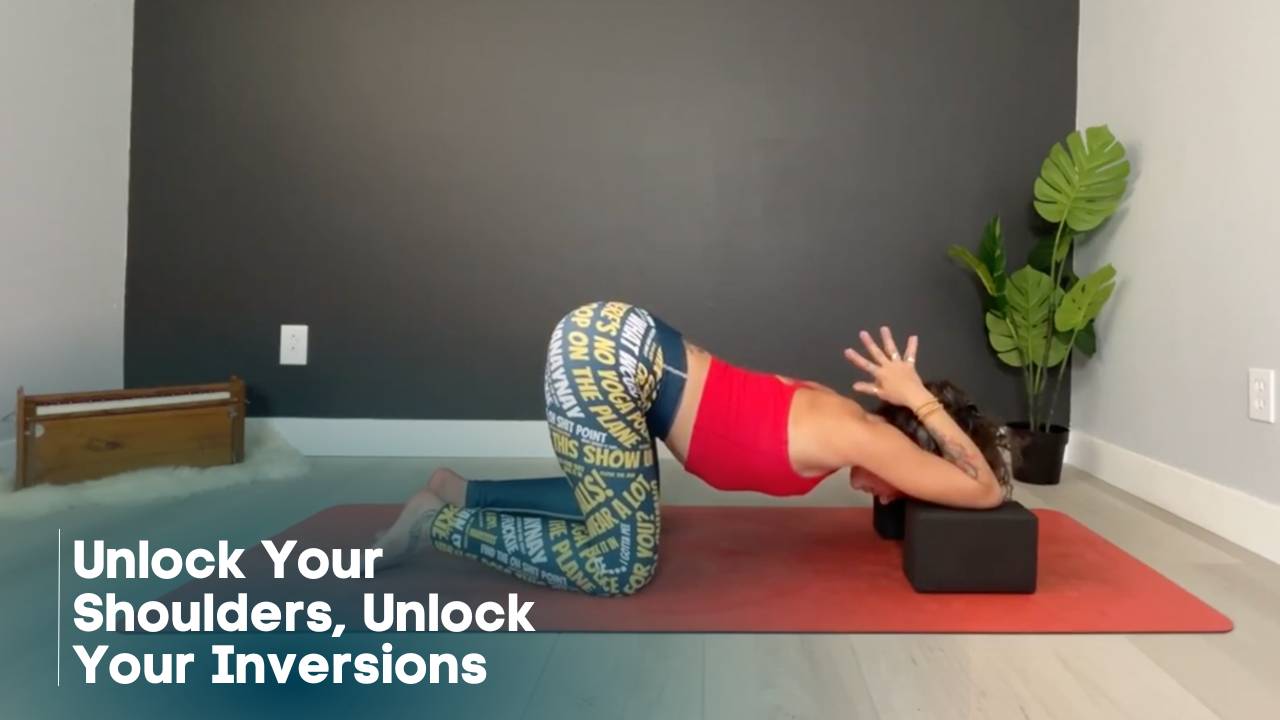Unlock Your Shoulders, Unlock Your Inversions

Going upside down should feel like controlled flight, not a battle with your own shoulders. But if your shoulders are tight, your lats stiff, or your overhead mobility limited, handstands, headstands, and forearm stands can feel impossible.
The challenge usually comes from shoulder flexion, which is how far you can lift your arms overhead. When your shoulders don’t open enough in this direction, your inversions look a little different: your upper back arches, your neck reaches forward, and you end up with a backbend. That’s why your inversions might feel wobbly and unstable.
In this week’s article, we’ll break down shoulder flexion, why it’s key for inversions, and look at some simple ways to open and engage your shoulders so your upside-down practice feels strong, safe, and smooth.
What is Shoulder Flexion?
Shoulder flexion is the movement that happens when you lift your arms in front of you and overhead. Imagine reaching up to grab a high shelf - that’s shoulder flexion in action.
Ideally (in life, and particularly in inversions), your arms should reach straight up so your biceps line up with your ears...that’s roughly 180 degrees of flexion. For most of us, though, life has other plans. Desk jobs, phones, driving, and even habitual posture all work together to tighten your lats, chest, and shoulders, making that overhead line feel unreachable.

Why Shoulder Flexion Matters for Inversions
In poses such as handstands, headstands, and forearm stands, your shoulders aren’t just there for show, they’re the foundation that keeps your entire body stacked and stable.
If your ability to take your shoulders into full (180 degrees) flexion is limited, your body starts to compensate when you're upside-down. Usually that means over-arching your upper back in the pose, shrugging your shoulders, or craning your neck forward. It might feel like you’re “making the pose work,” but in reality, these compensations throw off your balance, make the pose less efficient, and can strain your spine.
The good news is that perfect 180-degree flexion isn’t required to fly your inversions! You can still balance upside down, your shape will just be a little different from pin-straight. However, improving your range of shoulder flexion, and learning how to engage the right muscles upside down will make your inversions feel safer, stronger, and more controlled.
Shoulder Drills for Better Inversions
Here are some exercises that target the muscles that limit overhead flexion and that also teach you how to engage your shoulders properly for balance. You’ll need two blocks (or books, sturdy Tupperwares, possibly a willing cat) and a yoga mat.
1. Lat Release with Blocks
Place your blocks shoulder-width apart on your mat and bring your elbows to the center of each block. Stack your hips over your knees and allow your chest to sink toward the floor. Notice if you feel a stretch in your lats (the big "wing-like" muscles on the back and side of your body). Optional: add gentle Cat-Cow movements.
2. Upper Back and Chest Activation on All Fours
Come to a forearm table-top with elbows under shoulders. Sink your chest slightly toward the mat, then push the floor away to engage your serratus anterior and pec minor (your push muscles). Repeat this 3–5 times, feeling your shoulder blades spread apart and wrap around your rib cage each time you push. This is the engagement you’ll use in inversions.
3. Forward Shift Drill
From forearm table-top, slowly shift your weight forward as if you could kiss your thumbs, then return to your starting position. Repeat this 2–3 times. This teaches proper weight distribution while keeping shoulders engaged.
4. Dolphin Pose Shoulder Work
In Dolphin Pose, push the floor away and reach your chest toward your knees, creating space in the armpits. Slightly tuck your chin and tap your head lightly toward the mat, then lift back up. Repeat 2–3 times and notice what you feel in your entire upper body.
Each of these drills give your shoulders the length, strength, and coordination needed for inversions. You’re not just "Netflix and chillin'" in these poses - you’re training your shoulders to support your entire body upside down.
Even if your shoulder flexion is a short of 180 degrees, these drills reduce compensations, making inversions feel more stable, controlled, and safe. Practice these a few times per week, and your shoulders, arms, back, and inversions will thank you! Want even more shoulder drills? Check out this recent blog post on using MFR to open up your shoulders!).
Want to see all of this in action?
Check out my YouTube video where I break all of this (and more) down!
PS., If you want to take your inversion practice further, my signature program Yogi Flight School goes even deeper. Inside, you get full tutorials on over 30 arm balances and inversions, drills to build strength and coordination, and guidance on linking poses together seamlessly. Check out all the details of Yogi Flight School here!

